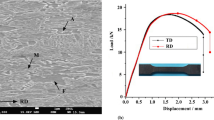Abstract
The aim of this paper is to suggest an approach to generate master curves by using miniature specimens, especially pre-cracked Charpy V-notched (PCVN) specimen, made of SA508 carbon steel. Firstly, fracture toughness diagram is derived from comparing finite element analyses results with the fixed mesh size at crack tip between standard compact tension and PCVN specimens. To compensate the constraint effects from different geometry, further examination based on the fracture toughness diagram was performed. In this context, a scale factor to deal with specimen size effects is proposed by statistically manipulating the numerical analysis data. Finally, the proposed scale factor is applied to calculate reference temperature which affects on the master curve. We expect that the approach can be applicable to compensate the geometrical constraint effects on fracture toughness of SA508 carbon steel when the PCVN specimen is used.
Similar content being viewed by others
References
E1921-05, Standard test method for determination of reference temperature, T0, for ferritic steels in the transition range, (2005), American Society of Testing Materials.
K. Wallin, Master curve analysis of ductile to brittle transition region fracture toughness round robin data, VTT Publications, 367 (1998).
K. Wallin, Master curve analysis of the “Euro” fracture toughness dataset, Engineering Fracture Mechanics, 69 (2002) 451–481.
F. Minami, A Brűchner-foit, D. Munz and B. Trolldenier, Estimation procedure for the Weibull parameters used in the local approach, International Journal of Fracture, 54 (1992) 197–210.
X. Gao, R. H. Dodds Jr., R. L. Tregoning, J. A. Joyce and R. E. Link, A Weibull stress model to predict cleavage fracture in plates containing surface cracks, Fatigue and Fracture of Engineering Materials and Structures, 22 (1999) 481–493.
Y. S. Chang, S. M. Lee, T. R. Lee, H. O. Ko, J. M. Kim and S. B. Choi, Analysis technology of local fracture behavior based on finite element method, KAERI/CM-999/2006, (2006).
B. S. Lee, W. J. Yang, M. Y. Huh, J. H. Kim and J. H. Hong, Evaluation of the fracture toughness transition characteristics of RPV steels based on the ASTM master curve method using small specimens, Transactions of the KSME (A), 24 (2000) 303–310.
M. Nevalainen and R. H. Dodds Jr., Numerical investigation of 3-D constraint effect on brittle fracture in SE (B) and C (T) specimens, International Journal of Fracture, 74 (1995) 131–161.
J. P. Petti and R. H. Dodds Jr., Coupling of the Weibull stress model and macroscale models to predict cleavage fracture, Engineering Fracture Mechanics, 71 (2004) 2079–2103.
K. C. Koppenhoefer and R. H. Dodds Jr., Loading rate effects on cleavage fracture of pre-cracked CVN specimens: 3-D studies, Engineering Fracture Mechanics, 58 (1997) 249–270. J. P. Petti and R. H. Dodds Jr., Constraint comparisons for common fracture specimens: C (T)s and SE (B)s, Engineering Fracture Mechanics, 71 (2004) 2677–2683.
ABAQUS/CAE Ver. 6.7, SIMULIA, (2007).
S. B. Choi, Y. S. Chang, Y. J. Kim, M. C. Kim and B. S. Lee, Mesh size effects on fracture toughness estimation bydamage, Transactions of the Korean Nuclear Society Spring Meeting, (2009) 519–520.
H. O. Ko, Y. S. Chang, Y. J. Kim, M. C. Kim and B. S. Lee, Fracture toughness estimation and constraint effect quantification by Weibull stress model, Transactions of the Korean Society of Pressure Vessels and Piping, 2 (2006) 31–38.
Author information
Authors and Affiliations
Corresponding author
Additional information
This paper was recommended for publication in revised form by Associate Editor Youngseog Lee
Shin-Beom Choi received his B.S. and M.S. in the school of Mechanical Engineering from Sungkyunkwan University, Korea, in 2006 and 2008, respectively. He is currently a Ph.D. Candidate in Sungkyunkwan University. His research interests include computational mechanics and fracture mechanics.
Young-Jin Kim received his Ph.D. from the Department of Mechanical Engineering in 1982 at University of Manitoba in Canada. Currently, he is a Professor in the School of Mechanical Engineering at Sungkyunkwan University. He is also director at Safety and Structural Integrity (SAFE) Research Center in Sungkyunkwan University. His current research interests are fracture mechanics and nano mechanics.
Rights and permissions
About this article
Cite this article
Choi, SB., Chang, YS., Kim, YJ. et al. Correction of constraint loss in fracture toughness measurement of PCVN specimens based on fracture toughness diagram. J Mech Sci Technol 24, 687–692 (2010). https://doi.org/10.1007/s12206-010-0120-2
Received:
Revised:
Accepted:
Published:
Issue Date:
DOI: https://doi.org/10.1007/s12206-010-0120-2




